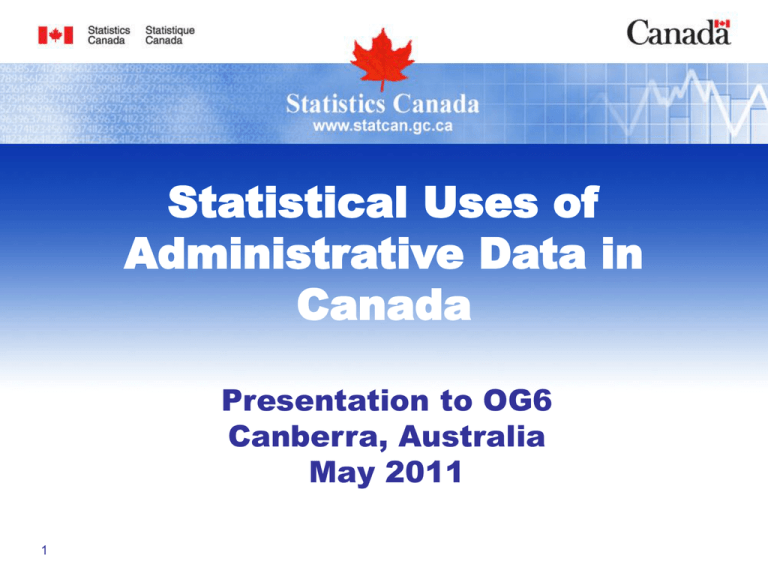Statistical Uses of Administrative Data in Canada Presentation to OG6
advertisement

Statistical Uses of Administrative Data in Canada Presentation to OG6 Canberra, Australia May 2011 1 Overview of presentation 2 What is administrative data? Applications of administrative data Sources Advantages and disadvantages Examples of use in the energy statistics program at Statistics Canada What is administrative data? Records collected and maintained by other government agencies to meet legislative or regulatory requirements: • To monitor activities related to the production and consumption of energy • To enable regulatory or audit activities • To assess outcomes of policies, programs, initiatives • To register particular events (e.g. business incorporations, licensing) 3 This differs from statistical data Statistical records: • Are used to study dimensions, trends and relationships of groups of persons or entities • Maintain the confidentiality of individual identifiable information • Are used to produce aggregates, averages, measures 4 Applications of administrative data Direct collection of data Substitution for survey data (e.g. for nonresponse, for replacement of strata) Estimation, edits, imputation Creation and support of survey frames Data analysis, validation Improving timeliness 5 Sources of administrative data Other government departments and agencies responsible for regulation, audit, evaluation • Can be national or sub-national Can be made available through: • A file of individual records • Aggregated data • A survey or census of administrative agencies 6 Advantages of using admin data Reduction in the overall costs of collection Reduction in burden placed on respondents Greater availability of small area data Possible reduction in errors due to census coverage Opportunities to link data to other admin sources Advances in technology make it easier, cheaper to manipulate and use large data files Useful in the development of survey frames 7 Disadvantages of using admin data Admin data are not primarily collected for statistical uses, which could lead to : • Inconsistent concepts, variables, definitions • Lack of follow-up, quality control • Possible breaks in series with changes to regulations, legislation, policy • Non-representative population • Timeliness concerns Does the statistical agency have a legal right to access? (Statistics Act) • Public concerns over confidentiality, intrusiveness? 8 Examples from the energy statistics program at Statistics Canada Using administrative data ... 9 For direct collection Where survey data do not exist Eg. Deregulation of the energy market created secondary distributors • Data collected from natural gas distributors and transporters on sales to residential, commercial and industrial sectors • A proxy for consumption data Eg. Import and export data from the National Energy Board • From admin files on permits 10 For direct collection As a supplement for existing data Eg. For monthly crude oil and natural gas production, imports, exports, domestic deliveries and inventories, data are collected through both survey & admin data • Producing provinces gather regulatory data 11 As a substitution for survey data Eg. Electric Utility Financial Report gathers an annual breakdown of a series of balance sheet and income statement items • In 2008, negotiated with Ontario Energy Board to gather aggregate admin data for 85 municipal respondents • Reduced costs, burden 12 For estimation, edits, imputation Where data are missing, incomplete, inconsistent with historical data Eg. Missing fuel consumption values are calculated using the change in fuel consumption by industry 13 To support survey frames All energy surveys recently hooked up to the Statistics Canada Business Register A good source of information to establish and maintain survey frames Promotes harmonization across department 14 For data analysis and validation Energy statistics program uses other sources of information for quality control, outlier detection, confrontation Examples: • Reports from industry associations • Reports from other government departments 15 For improving timeliness Program is working to accelerate the collection and reporting of key petroleum production data • Using data from the Petroleum Registry of Alberta (PRA) as a starting point, to eliminate duplicate reporting • PRA collects data for regulatory purposes • The application may be extended to other producing provinces 16 For the future... Other applications under investigation: • Tax data, to replace financial reporting • Public sector statistics, for data on electric utilities – operating revenues and expenditures, sales of electricity, using income statements and balance sheets Currently assessing survey data vs admin 17 Conclusion Statistics Canada is relying more on admin data Driving factors: fiscal restraint, evolving technology, respondent burden Success based on legislative authority + ongoing collaboration Need to be aware of the constraints and challenges of using admin data 18 For more information Andy Kohut Director, Manufacturing & Energy Division Statistics Canada 11th Floor, Jean Talon Building, section B-8 Ottawa, Ontario CANADA K1A 0T6 613-951-5858 Andy.Kohut@statcan.gc.ca 19


